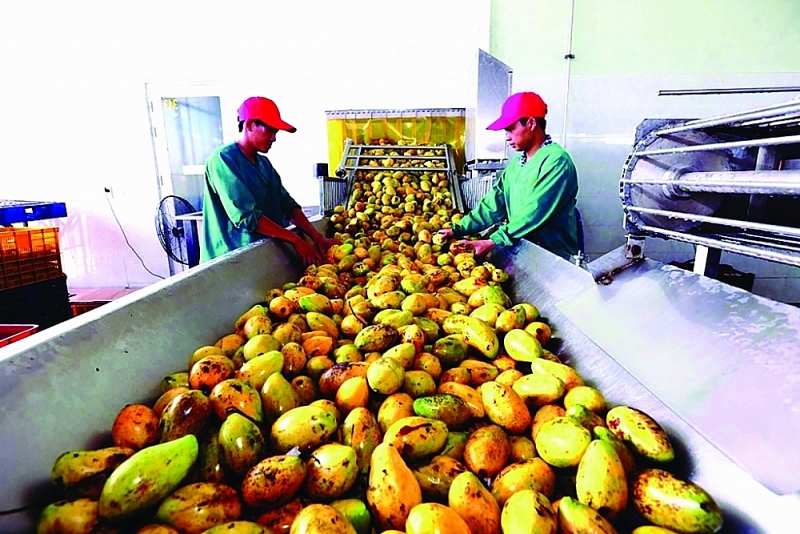The two "main drivers" in agricultural export still have weaknesses
Exporting rice and vegetables have many advantages in the market. These are two key products that continue to help agricultural exports earn more foreign currency. However, there are still limitations and weaknesses in growing areas, unequal quality and business linkages.
 |
|
Fruit and vegetable exports to key markets continue to increase. Photo: N.T |
There are positive signs in export
Mr. Nguyen Ngoc Nam, Chairman of the Vietnam Food Association, informed that in the first 4 months of the year, Vietnam exported 3.4 million tons of rice with a turnover of more than USD 2 billion. It is estimated that by May 30, total output will be 3.6 tons; turnover will be more than USD 2.3 billion, an increase of 11% in quantity and 34% in value.
Mr. Nam added that Vietnamese rice also focuses on large markets such as Philippines, China, Indonesia... In the first 5 months of the year, domestic rice prices increased compared to the same period, ensuring efficiency for farmers and rice growers.
It is forecast that Vietnam's rice exports in 2024 will prosper when major markets increase import volumes. "Countries are waiting to see if India will lift its export restrictions banning rice exports due to El Nino. It is possible that it will not be lifted until September. This is an opportunity for Vietnam," Mr. Nguyen Ngoc Nam said.
In the fruit and vegetable industry, Mr. Nguyen Thanh Binh, Chairman of the Vietnam Fruit and Vegetable Association, said that by May 20, Vietnam's fruit and vegetable export turnover reached USD 2.490 billion, an increase of 25.7% over the same period last year, 2023. Key markets continue to increase, China tops at USD 1,156 million, Korea USD 107 million.
According to Mr. Binh's assessment, from the 4-month fruit and vegetable export data, through trade promotion in Europe, the US and the situation of businesses, it is forecast that export activities of this item will continue to be favorable with demand increasing in traditional markets continues to increase, especially durian, watermelon, and mango.
Mr. Nguyen Anh Son, Director of the Import-Export Department (Ministry of Industry and Trade) also assessed that export activities of the agricultural product industry have overcome difficulties and achieved positive results.
According to the General Department of Customs, in the first 4 months of 2024, Vietnam's rice export results increased by 9.5% in volume and 33.6% in value compared to the same period last year; fruit and vegetable exports increased by 38.1% in value. For the fruit and vegetable industry, exports to the Chinese market account for 61.4% of the total export turnover of products.
Despite many positive results, however, many opinions say that Vietnam's rice and fruit and vegetable export activities still have limit ations and weaknesses.
Linkage and cooperation are the weaknesses of businesses
At the meeting between the Ministry of Industry and Trade and the Ministry of Agriculture and Rural Development on the production and export of rice and vegetables in the first 4 months of the year and discussed solutions to overcome difficulties and promote exports in the last months of 2024 On May 28, Minister of Agriculture and Rural Development Le Minh Hoan said that we are currently exporting a product of a business, not a product of an industry. Linkage and cooperation are the weak points of the business.
Minister Le Minh Hoan said: "When we go to international fairs, China exhibits an entire space, but in Vietnam, there are businesses that still rent a separate corner outside and do not go with an association or ministries and branches. Obviously, if businesses don't change, they can't go far," and further emphasized that exporting Vietnamese rice is about the image of Vietnamese rice, the image of Vietnamese agricultural products, not just about rice of Trung An, or another rice business. Only then can Vietnamese agricultural products grow.
Stating specifically the limit ations in exporting rice and vegetables, Mr. Nguyen Anh Son said that the production and processing processes of producers and businesses do not completely comply with strict quality regulations. Requirements for traceability and growing area codes; production scale is still small, scattered, not interconnected, quality is not stable, export products are still in raw form, lacking deep processing; some businesses have not mastered the regulations and policies of the import market or the requirements accompanying incentives from FTAs; some businesses have not focused on building brands and promoting products...
To achieve the goal of export recovery, increasing by about 6% compared to 2023, the Import-Export Department believes that it is necessary to remove difficulties for businesses and support production; promote market information and trade promotion; effectively take advantage of opportunities from trade agreements, negotiate market opening, respond to technical barriers, trade defense measures...
According to the Department of Crop Production (Ministry of Agriculture and Rural Development), the expected rice production area in 2024 is estimated at 7.09 million hectares, with an average yield of 61.2 tons/ha, an increase of about 0.2 tons /ha compared to 2023; Output is estimated at 43.4 million tons of rice, down about 35 thousand tons compared to 2023.
It is expected that the vegetable production area in 2024 will be about 1,030 thousand hectares (an increase of about 30 thousand hectares compared to 2023), the expected productivity will reach 191.5 tons/ha (about 0.5 tons/ha higher than 2023), output is expected to reach 19.7 million tons (about 624 thousand tons higher than 2023).
If from now until the end of the year, there are no unusual developments in weather, natural disasters, or epidemics, rice and vegetable production in 2024 will ensure the proposed plan in terms of area, productivity, and output; meet domestic consumption needs and at the same time ensure the amount of rice for export is about 7.6 million tons.








